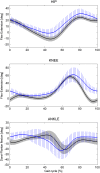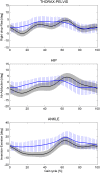Gait Kinematic Analysis in Water Using Wearable Inertial Magnetic Sensors
- PMID: 26368131
- PMCID: PMC4569370
- DOI: 10.1371/journal.pone.0138105
Gait Kinematic Analysis in Water Using Wearable Inertial Magnetic Sensors
Abstract
Walking is one of the fundamental motor tasks executed during aquatic therapy. Previous kinematics analyses conducted using waterproofed video cameras were limited to the sagittal plane and to only one or two consecutive steps. Furthermore, the set-up and post-processing are time-consuming and thus do not allow a prompt assessment of the correct execution of the movements during the aquatic session therapy. The aim of the present study was to estimate the 3D joint kinematics of the lower limbs and thorax-pelvis joints in sagittal and frontal planes during underwater walking using wearable inertial and magnetic sensors. Eleven healthy adults were measured during walking both in shallow water and in dry-land conditions. Eight wearable inertial and magnetic sensors were inserted in waterproofed boxes and fixed to the body segments by means of elastic modular bands. A validated protocol (Outwalk) was used. Gait cycles were automatically segmented and selected if relevant intraclass correlation coefficients values were higher than 0.75. A total of 704 gait cycles for the lower limb joints were normalized in time and averaged to obtain the mean cycle of each joint, among participants. The mean speed in water was 40% lower than that of the dry-land condition. Longer stride duration and shorter stride distance were found in the underwater walking. In the sagittal plane, the knee was more flexed (≈ 23°) and the ankle more dorsiflexed (≈ 9°) at heel strike, and the hip was more flexed at toe-off (≈ 13°) in water than on land. On the frontal plane in the underwater walking, smoother joint angle patterns were observed for thorax-pelvis and hip, and ankle was more inversed at toe-off (≈ 7°) and showed a more inversed mean value (≈ 7°). The results were mainly explained by the effect of the speed in the water as supported by the linear mixed models analysis performed. Thus, it seemed that the combination of speed and environment triggered modifications in the joint angles in underwater gait more than these two factors considered separately. The inertial and magnetic sensors, by means of fast set-up and data analysis, can supply an immediate gait analysis report to the therapist during the aquatic therapy session.
Conflict of interest statement
Figures



References
-
- Skelton DA Dinan SM. Exercise for falls management: rationale for an exercise programme aimed at reducing postural instabiliy. Physiotherapy Theory and Practice. 1999; 15:105–120.
-
- Konlian C. Aquatic therapy: making a wave in the treatment of low back injuries. Orthop Nurs. 1999; 18(1): 11–18. - PubMed
-
- Watanabe E, Takeshima N, Okada A, Inomata K. Comparison of water- and land-based exercise in the reduction of state anxiety among older adults. Percept.Mot.Skills. 2000; 91(1): 97–104. - PubMed
-
- Alikhajeh Y, Hosseini SRA, Moghaddam A. Effects of Hydrotheraphy in static and dynamic balance among elderly men. Procedia Social and Behavioral Sciences. 2012; 46:2220–2224.
Publication types
MeSH terms
Substances
LinkOut - more resources
Full Text Sources
Other Literature Sources

